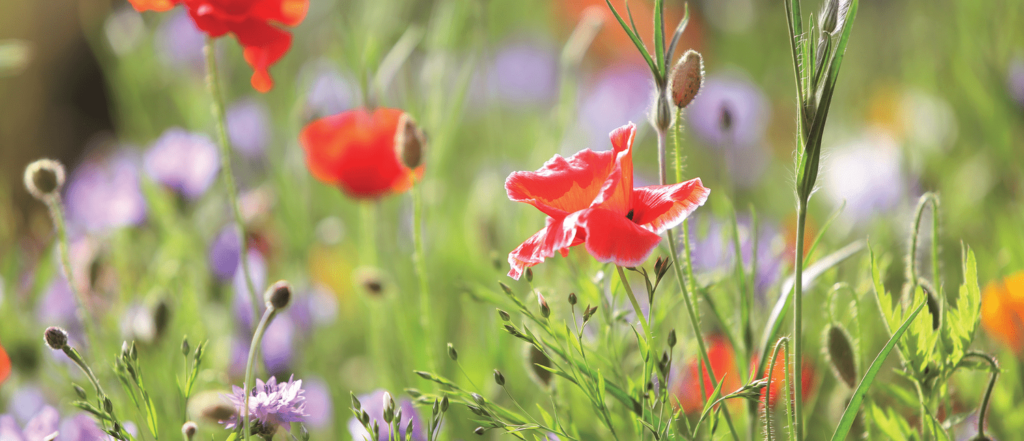GROWING A WILDFLOWER GARDEN FROM SCRATCH
WRITTEN BY RONDA SWANEY
Wildflowers evolved to thrive in less-than-ideal spots without the aid of gardeners. Their tenacity and beauty make them great, low-maintenance additions to a garden. While wildflowers take little effort to maintain, they require a bit of work to start. Here are some steps to infuse your garden with wild whimsy.

Pick a Spot.
If this is your first wildflower garden, start small. Choose an area only a few feet wide and long. This will help you learn what’s involved in starting and maintaining the garden, as well as ensuring you like the effect and the effort required to sustain it. Most wildflowers need sun, so choose a spot that gets six or more hours of daily sunlight.
Prepare the Area.
Remove grass or weeds by hand, with a rototiller, or through solarizing. To solarize a spot, mow any vegetation as low as your mower will allow, wet the ground, then top it with a secured clear plastic sheet. Keep the sheeting in place for weeks (two to six weeks, hot-and dry-weather dependent). Trapped heat will kill the vegetation, so the University of Minnesota Extension recommends starting this process in late summer. Remove the sheeting, rake, and remove the dead vegetation. Once your plot is cleared, you may want to test the soil to determine if it needs amendments like nitrogen, phosphorous, or fertilizer. Till in compost or topsoil to help your seeds or plants take root.
Choose What to Plant.
Purchase or prepare your own seed mixes or buy wildflower plants from a garden center. For seeds, follow packet instructions; but in general, scatter on the ground, lightly water, and then water regularly until they germinate. Wildflower seeds tend to be small and lightweight, so gardening professionals recommend adding sand to your seed mix to help them stay in place. If the weather is dry, you may need to water until they reach maturity. If installing plants from a nursery, again, water as needed until the plants are mature enough to thrive on their own. (Check out the sidebar for some hardy, colorful flowers worth trying.)
Set It Up for Success.
In the first year or two, you may need to weed like you do other higher maintenance plots. With time, however, your garden should become thicker and better able to fend off weed growth. You also may notice thin spots where you’ll need to add and then tend another round of seeds to maturity.
Mow It Down.
Once the blooming season is over, mow your garden down to about four to six inches in height. This trim serves a few purposes: it ensures the seed heads drop so the plants will regrow next season; it makes the plot look neater during autumn and winter; and it helps prevent the plants from overtaking other areas of your garden.
Photography provided by kirin_photo/iStock/Getty Images Plus.
sow to speak.
Looking to start fresh with wildflowers? Here are some easy-to-grow, sun-loving varieties. Check with your local nursery or extension for plants that may be invasive in your region.
Aster: usually purple or white, and benefit from full to partial sun.
Candytuft: white, pink, or purple, and prefer full sun.
Sunflower: tall yellow plants that require full sun.
Black-eyed Susan: yellow flowers that need full sun.
Nasturtium: red, orange, or yellow flowers (sometimes with creamy or white leaves) that grow in full sun.
Yarrow: white, red, yellow, or pink flowers that enjoy full sun.
Sweet William: light to dark pink and purple blooms that prefer sun to partial shade.
Common foxglove: usually shades of white, pink, and purple that prefer morning sun and afternoon shade.
Shasta daisy: usually white, and good in full sun or light shade.



